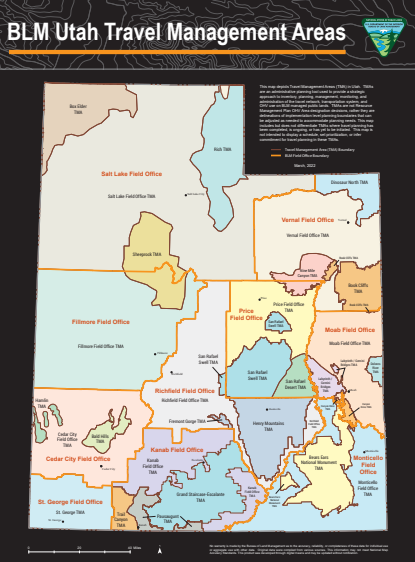Breaking News-Moab Injunction Hearing February 21, 2024
The hearing for a stay or temporary injunction of the Moab Labyrinth Canyon/Gemini Bridges Travel Management Plan was held on February 21before the Honorable Dale A. Kimball in Salt Lake City. The OHV community turned out in force to observe the hearing, which Judge Kimball mentioned that it was good to see so many concerned citizens turn out to fill his courtroom.
This hearing was for the Federal lawsuit filed by BlueRibbon Coalition, Patrick McKay, and Colorado Off Highway Trail Defenders against BLM. The judge allowed SUWA to act as an intervenor in the case. Plaintiffs were represented by Matt Miller and Nate Curisi with Texas Public Policy Group, defendants were represented by Paul Turcke and Steve Bloch. Final prehearing briefs from both attorneys are attached if you’d like to read them.
To qualify for an injunction, four elements must be proven:
- That Plaintiffs are likely to prevail on the merits. Matt Miller presented four counts for violations and the reasons that plaintiff was likely to prevail on all 4 of them. It is only necessary for the Plaintiff to prevail on one of the counts.
- That Plaintiffs will suffer irreparable harm if relief is not granted. Substantial focus, including questions from Judge Kimball, surrounded the impact of BLM’s intent to “obliterate” the trails in their plan. Another focus was that some of the arguments in the 4 counts were constitutional violations, which automatically qualify them as being irreparable.
- That the Plan was arbitrary and capricious in it’s evaluation and implementation. BLM is required to take a “hard look” at the impacts from implementation of the plan, and cannot consider factors not intended by Congress. Many examples of infractions occurred including improper analysis of science and the failure of BLM to respond to significant and relevant comments, including the impact to recreation, including Elderly and Disabled users. Another important example was the inclusion of user conflicts citing noise without any precise definition of what noise levels were acceptable or unacceptable.
- That relief is not adverse to the public interest and that plaintiff’s injuries outweigh any alleged damage to defendants. Since the current TMP has been in effect for 15 years, delaying the effective date of the new plan will not result in any new harms to BLM, while without relief, the many users, including those that are elderly or handicapped, are deprived of the opportunity to enjoy these areas is both substantial and irreparable. One of the largest Off Road Events in the world, Easter Jeep Safari, had 9% of it’s historic trails closed by this Plan. In addition, public interest has been demonstrated by both the volume of public comments, and efforts by Federal and Utah legislators who have introduced legislation to overturn this Plan.
So what does this mean? Judge Kimball closed the hearing after about 2 hours of arguments and will issue his ruling in “short order.” Judge Kimball has a reputation for a strong understanding of land use issues in the 10th Circuit, and also for issuing rulings quickly, so we hope to see his ruling in a short period of time. It should be noted that this Injunction Hearing is only the first step in this effort, regardless of this ruling, the Federal Lawsuit will still be heard at a later date.
I am not an attorney, but my lay opinion was that Matt Miller did a much more persuasive job than Turcke and Bloch, and Judge Kimball’s questions seemed to bolster Miller’s presentation, while they seemed more critical of BLM’s arguments.
I’ve learned that nobody can predict the outcome of any court hearing, but I’m both optimistic about our potential for success in this first step and proud and grateful of the actions taken by BlueRibbon, Patrick McKay, and Colorado Offroad Trail Defenders for standing up for our rights. Please make sure you let them know that you support them too.

